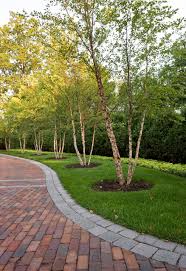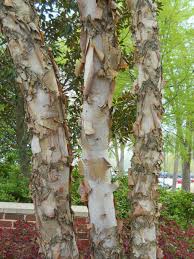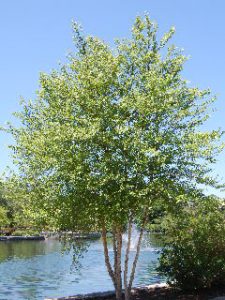 River Birch Tree
River Birch Tree
The River Birch, Betula Nigra, has other names such as the red birch, black birch or the water birch depending on where it is growing. It commonly grows in the southeastern United States where they typically grow in thickets along the lakeshores and rivers. The River Birch is the most common and distributed birch tree in the states. It is also the best-adapted tree to hot climates. The river birch tree is commonly used for landscaping purposes since it has graceful drooping branches and a glamorous color pleasing to the eye.
The River Birch is a fast growing, deciduous semi-aquatic tree that grows up to 50 to 90 feet in height. It has a diamond shape, double-toothed leaves and creates an erect or spreading canopy that covers an extensive area. The leaves of the Red Birch tree turn a yellow color in the fall. During its early stages, its bark is usually silver grey but changes to either pin or red when it matures. The red birch trees produce beautiful flowers during the spring and winter and small brown cones in the summer. It is pruned to prevent many unwanted branches and also to maintain a particular shape and beauty since they are mostly used for landscaping purposes.
The river birch tree grows in either the full sun glare or in a shaded region. It prefers a slightly acidic soil but can grow in either acidic, slightly alkaline, loam, sand or clay soil. It is hardy in the sense that its growth cannot be deterred by the soil type or level of acidity. It is somewhat tolerant to drought, but it grows superbly well in moist soil. Unlike most of its species, it is resistant to bronze birch borer and verticillium. Though the red birch is easily susceptible to chlorosis in high pH as well as to aphids, beetle borers, leaf spots and anthracnose, these conditions and the pests attacking it causes minimal damage and should not be of great concern.
It is used mostly used as an ornamental tree, offers fall and winter color to parks, yards and streets pavements. The leaves of the red birch turn yellow during the autumn, during the winter, its trunk normally turns silver adding beauty to the environment or landscape. It has durable wood which makes it easy to work with while making a variety of items such as artificial commodities, children’s toys, and flatware. It is also a good source of controlling soil erosion in sloppy areas and along the river banks. It is also used to reclaim areas with high soil acid caused by mining. Wildlife, such as birds and rodents eat its seeds and herbivores like the deer and others can feed on its twigs and leaves.
Attributes
- Produces brown and green catkins.
- Yields a large number of tiny nutlets after female catkins mature.
- It can either grow as a single or multi-stemmed tree.
- Grows in an oval shape. It is pest resistant.
- Works well for holding stream banks and keeping erosion in check.
